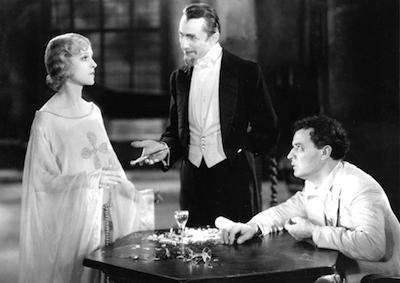In a foreboding mountaintop castle an evil necromancer, attended by an avian familiar, holds a virgin princess spellbound. Guided by a wise elder, her lover storms the aerie, overcomes the hideous creatures that guard it, destroys the sorcerer and rouses his beloved from her enchantment. Walt Disney’s Snow White and the Seven Dwarfs (1937) or Sleeping Beauty (1959)? No, the Halperin Brothers’ White Zombie. The most famous horror movie from Poverty Row is nothing but a fairy tale in mufti, pegged to a jazz age voodoo vogue popularized by William Seabrook’s occult writings.
Quickly produced on the cheap to exploit the post-Dracula horror film cycle, White Zombie was sneered at for decades before its rehabilitation in the 1960s by scholars like William Everson, Carlos Clarens and Arthur Lennig. An incredibly two-brained film, White Zombie’s reach far exceeds its grasp. Within five minutes its ostensible setting in contemporary Haiti is discounted as the story reels backward into realms of mythological romanticism. Performances and line readings worthy of bad regional dinner theater abruptly segue into camera moves and Cocteau-like imagery that are the definition of cinema, underscored by fruity library music of overwhelming panache. At the center of it all is Bela Lugosi, giving a signature performance of Mephistophelean malevolence that, after 80 years, still rings down the corridors of time.
A crazy, ineffable critical mass was reached in White Zombie making it an unequivocal pop culture signpost whose influence has left an imprint on everything from Disney family values to Rob Zombie’s metronymic heavy metal band. It codified the Lugosi chick magnet persona in ways that even Dracula (1931) never could (to wit the televangelical White Zombie fever dream shared by Johnny Depp and Martin Landau in Tim Burton’s Ed Wood, 1994). The film’s back-of-the-head magic is perhaps best not explicated but simply appreciated. As quizzically declared by Madge Bellamy’s doe-eyed, kewpie doll heroine upon waking from her reverie, “I dreamed!” —Scott MacQueen
Director: Victor Halperin. Production: Halperin Productions. Distribution: United Artists. Producer: Edward Halperin. Screenwriter: Garnett Weston. Cinematographer: Arthur Martinelli. Art Direction: Ralph Berger. Editor: Howard McLernon. Music: Abe Meyer. Cast: Bela Lugosi, Madge Bellamy, Joseph Cawthorn, Robert Frazer, John Harron. 35mm, b/w, 68 min.
Restored from an incomplete 35mm composite nitrate print, an original 35mm acetate 1952 reissue print, an original 1952 16mm print, 35mm acetate dupe negative reels and two 35mm acetate dupe negative reissue prints. Laboratory services by The Stanford Theatre Film Laboratory, Audio Mechanics, DJ Audio, Simon Daniel Sound. Special thanks to: the Library of Congress; Greg Luce—Sinister Cinema; Samuel M. Sherman—Independent-International Pictures Corp.






 Mobile Navigation
Mobile Navigation

